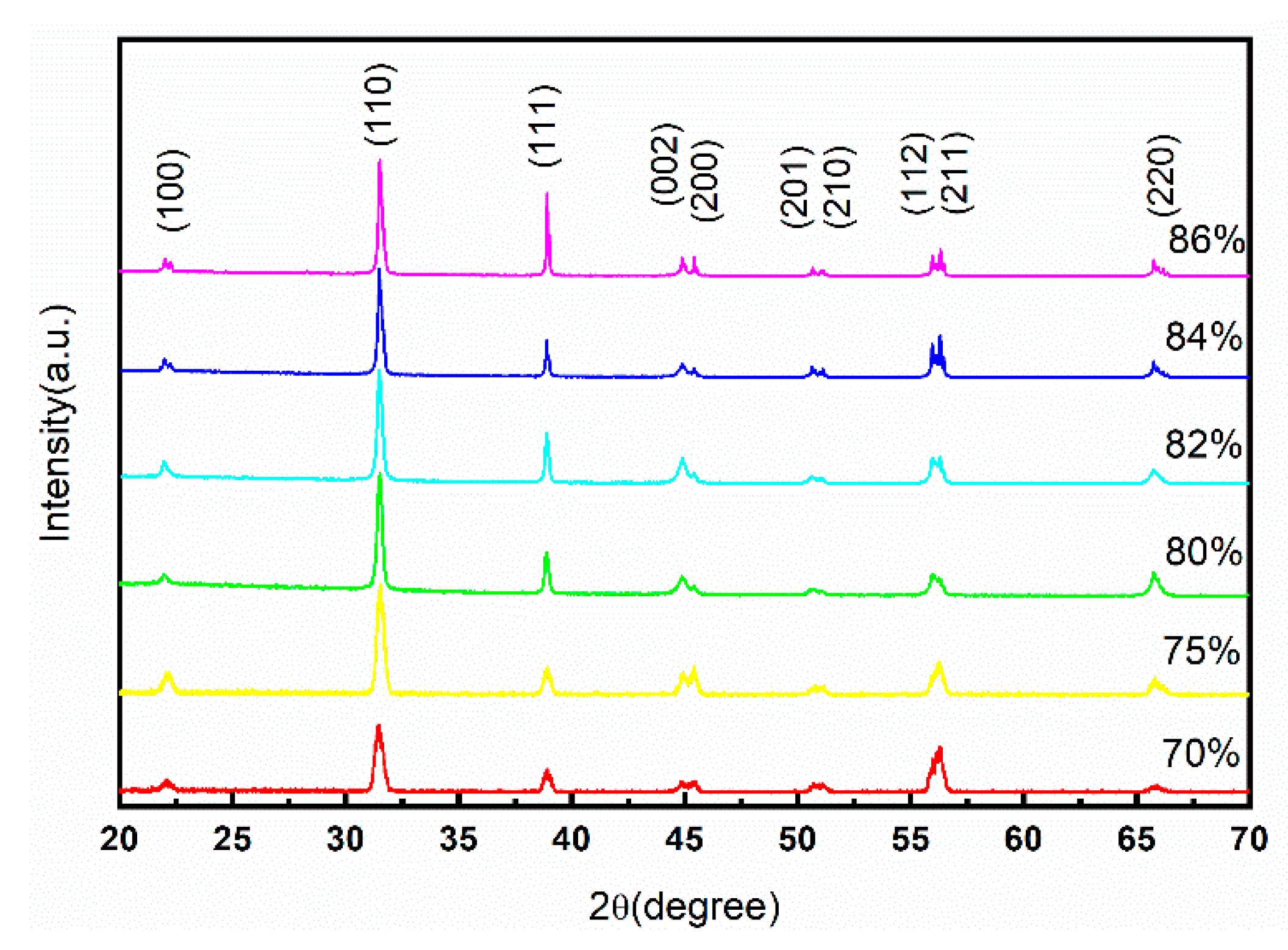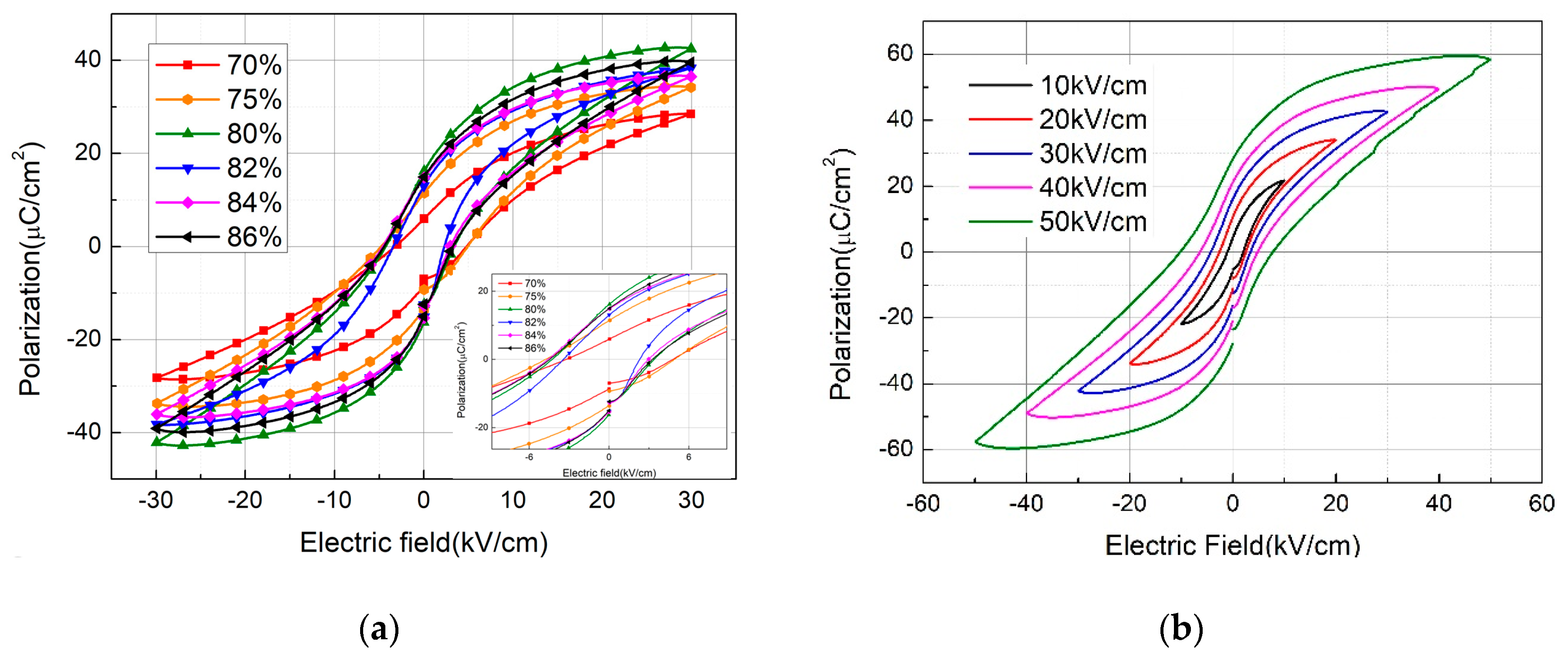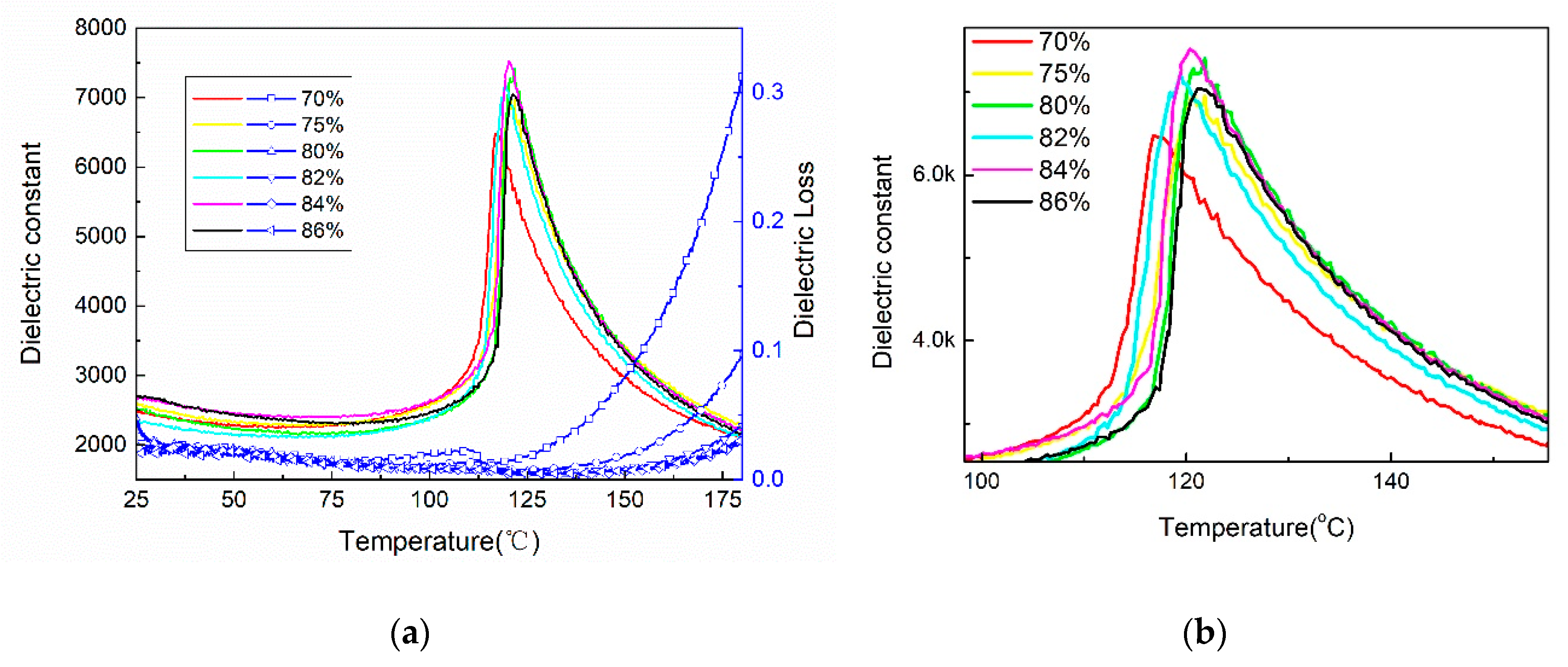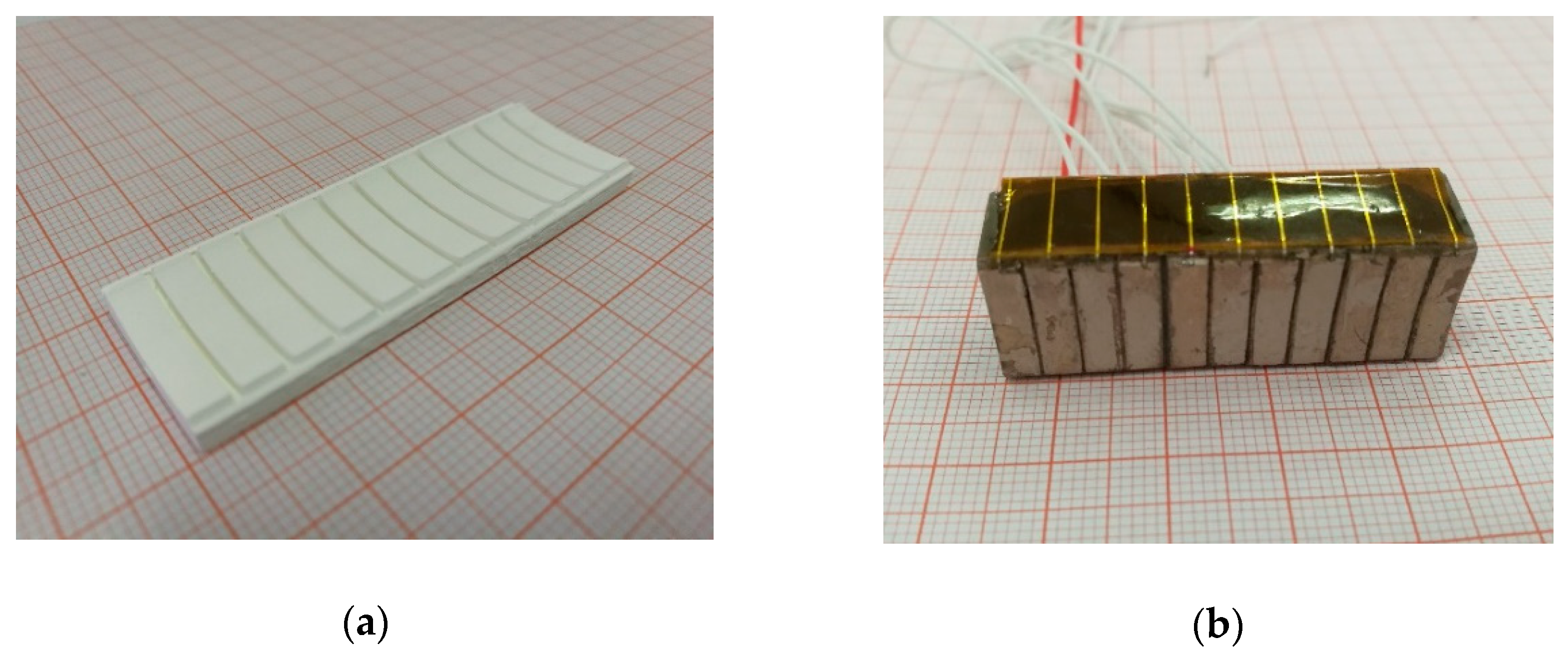3D Printing of BaTiO3 Piezoelectric Ceramics for a Focused Ultrasonic Array
Abstract
:1. Introduction
2. Experimental
2.1. BTO Slurry and Green Parts
2.2. BTO Ceramics Characterization
3. Results and Discussions
3.1. BTO Ceramics Characterization
3.1.1. Microstructure
3.1.2. XRD Patterns
3.1.3. Electrical Properties
3.2. 3D Printing Focused Ultrasonic Transducer
4. Conclusions
Author Contributions
Funding
Conflicts of Interest
References
- Gao, J.-H.; Xue, D.-Z.; Liu, W.-F.; Zhou, C.; Ren, X.-B. Recent Progress on BaTiO3-Based Piezoelectric Ceramics for Actuator Applications. Actuators 2017, 6, 24. [Google Scholar] [CrossRef]
- Kim, K.; Zhu, W.; Qu, X.; Aaronson, C.; McCall, W.R.; Chen, S.-C.; Sirbuly, D.J. 3D Optical Printing of Piezoelectric Nanoparticle-polymer Composite Materials. ACS Nano 2014, 8, 9799–9806. [Google Scholar] [CrossRef] [PubMed]
- Park, J.Y.; Kang, Y.Y.; Yoon, H.W.; Park, N.K.; Jo, Y.-J.; Jeong, S.-H.; Won, J.C.; Kim, Y.H. Viscoelastic Properties of a 3D-Printable High-dielectric Paste with Surface-modified BaTiO3. Compos. Sci. Technol. 2018, 159, 225–231. [Google Scholar] [CrossRef]
- Rouffaud, R.; Granger, C.; Hladky-Hennion, A.-C.; Thi, M.P.; Levassort, F. Tonpilz Underwater Acoustic Transducer Integrating Lead-free Piezoelectric Material. Phys. Procedia 2015, 70, 997–1001. [Google Scholar] [CrossRef] [Green Version]
- Matuda, M.Y.; Buiochi, F.; Adamowski, J.C. Imaging through a Convex Interface with Unknown Position and Shape using an ultrasonic linear array. AIP Conf. Proc. 2012, 1433, 177–180. [Google Scholar]
- Landhuis, E. Ultrasound for the brain. Nature 2017, 551, 257–259. [Google Scholar] [PubMed]
- Xia, J.; Yang, Y.; Hu, C.; Meng, R.; Jiang, Q.; Liu, R.; Yu, Y.; Sheng, Z.; Yan, F.; Zhang, L.; et al. Evaluation brain tumor in small animals using plane-wave-based power Doppler imaging. Ultrasound Med. Biol. 2019, 45, 811–822. [Google Scholar] [CrossRef] [PubMed]
- Deckers, J.; Vleugels, J.; Kruth, J.P. Additive Manufacturing of Ceramics: A Review. J. Ceram. Sci. Tech. 2014, 5, 245–260. [Google Scholar]
- Travitzky, N.; Bonet, A.; Dermeik, B.; Fey, T.; Filbert-Demut, I.; Schlier, L.; Schlordt, T.; Greil, P. Additive Manufacturing of Ceramic-based Materials. Adv. Eng. Mater. 2014, 16, 729–754. [Google Scholar] [CrossRef]
- Cui, H.; Hensleigh, R.; Yao, D.; Maurya, D.; Kumar, P.; Kang, M.G.; Priya, S.; Zheng, X. Three-dimensional printing of piezoelectric materials with designed anisotropy and directional response. Nat. Mater. 2019, 18, 234–241. [Google Scholar] [CrossRef]
- Li, K.; Zhao, Z. The Effect of the Surfactants on the Formulation of UV-curable SLA Alumina suspension. Ceram. Int. 2017, 43, 4761–4767. [Google Scholar] [CrossRef]
- Chen, Z.; Li, Z.; Li, J.; Liu, C.; Lao, C.; Fu, Y.; Liu, C.; Li, Y.; Wang, P.; He, Y. 3D Printing of Ceramics: A Review. J. Eur. Ceram. Soc. 2019, 39, 661–687. [Google Scholar] [CrossRef]
- Dufaud, O.; Marchal, P.; Corbel, S. Rheological Properties of PZT Suspensions for Stereolithography. J. Eur. Ceram. Soc. 2002, 22, 2081–2092. [Google Scholar] [CrossRef]
- Singh, P.; Smith, S.; Bezdecny, M.; Cheverton, M.; Brewer, J.A.; Venkataramani, V. Additive Manufacturing of PZT-5H Piezoceramic for Ultrasound Transducers. In Proceedings of the IEEE International Ultrasonics Symposium, Orlando, FL, USA, 18–21 October 2011; pp. 1111–1114. [Google Scholar]
- Yang, Y.; Chen, Z.-Y.; Song, X.; Zhu, B.-P.; Hsiai, T.; Wu, P.-I.; Xiong, R.; Shi, J.; Chen, Y.; Zhou, Q.-F.; et al. Three Dimensional Printing of High Dielectric Capacitor using Projection based Stereolithography Method. Nano Energy 2016, 22, 414–421. [Google Scholar] [CrossRef]
- Chen, Y.; Bao, X.-L.; Wong, C.-M.; Cheng, J.; Wu, H.-D.; Song, H.-Z.; Ji, X.-R.; Wu, S.-H. PZT Ceramics Fabricated based on Stereolithography for An Ultrasound Transducer Array Application. Ceram. Int. 2018, 44, 22725–22730. [Google Scholar] [CrossRef]
- Woodward, D.I.; Purssel, C.P.; Billson, D.R.; Hutchins, D.A.; Leigh, S.J. Additively-Manufactured Piezoelectric Devices. Phys. Status Solidi A Appl. Mater. Sci. 2015, 212, 2107–2113. [Google Scholar] [CrossRef]
- Chen, W.; Wang, F.-F.; Yan, K.; Zhang, Y.-H.; Wu, D.-W. Micro-Stereolithography of KNN-based Lead-free Piezoceramics. Ceram. Int. 2019, 45, 4880–4885. [Google Scholar] [CrossRef]
- Jang, J.H.; Wang, S.; Pilgrim, S.M.; Schulze, W.A. Preparation and Characterization of Barium Titanate Suspensions for Stereolithography. J. Am. Ceram. Soc. 2000, 83, 1804–1806. [Google Scholar] [CrossRef]
- Chen, Z.-Y.; Song, X.; Lei, L.-W.; Chen, X.-Y.; Fei, C.-L.; Chiu, C.T.; Qian, X.-J.; Ma, T.; Yang, Y.; Shung, K.; et al. 3D Printing of Piezoelectric Element for Energy Focusing and Ultrasonic sensing. Nano Energy 2016, 27, 78–86. [Google Scholar] [CrossRef]
- Chen, Z.-Y.; Qian, X.-J.; Song, X.; Jiang, Q.-G.; Huang, R.-J.; Yang, Y.; Li, R.-Z.; Shung, K.; Chen, Y.; Zhou, Q.-F. Three-Dimensional Printed Piezoelectric Array for Improving Acoustic Field and Spatial Resolution in Medical Ultrasonic Imaging. Micromachines 2019, 10, 170. [Google Scholar] [CrossRef]
- Vijatovic, M.M.; Bobic, J.D.; Stojanovic, B.D. History and Challenges of Barium Titanate: Part II. Sci. Sintering 2008, 40, 235–244. [Google Scholar] [CrossRef]
- Chen, Y.; Zhou, D.; Lam, K.-H.; Cheung, K.-F.; Dai, J.-Y.; Chan, H.L.-W. Endoscopic Ultrasound Radial Array Transducers Fabricated with PZT Tube by a Rotate-and-dice Method. Sens. Actuators A Phys. 2013, 201, 357–362. [Google Scholar] [CrossRef]






| BTO Weight Percentage | 70 wt% | 75 wt% | 80 wt% | 82 wt% | 84 wt% | 86 wt% |
|---|---|---|---|---|---|---|
| Density (g/cm3) | 5.52 | 5.57 | 5.65 | 5.62 | 5.63 | 5.68 |
| BTO Weight Percentage Electrical Properties | 70 wt% | 75 wt% | 80 wt% | 82 wt% | 84 wt% | 86 wt% | BTO Ceramic [22] |
|---|---|---|---|---|---|---|---|
| d33 (pC/N) | 96 | 110 | 166 | 130 | 124 | 122 | 190 |
| εr (1 kHz) | 1829 | 2175 | 2177 | 2210 | 2251 | 2276 | 1700 |
| tan δ | 0.094 | 0.076 | 0.036 | 0.040 | 0.036 | 0.036 | <0.1 |
| kt | 0.29 | 0.36 | 0.41 | 0.42 | 0.39 | 0.17 | - |
© 2019 by the authors. Licensee MDPI, Basel, Switzerland. This article is an open access article distributed under the terms and conditions of the Creative Commons Attribution (CC BY) license (http://creativecommons.org/licenses/by/4.0/).
Share and Cite
Cheng, J.; Chen, Y.; Wu, J.-W.; Ji, X.-R.; Wu, S.-H. 3D Printing of BaTiO3 Piezoelectric Ceramics for a Focused Ultrasonic Array. Sensors 2019, 19, 4078. https://doi.org/10.3390/s19194078
Cheng J, Chen Y, Wu J-W, Ji X-R, Wu S-H. 3D Printing of BaTiO3 Piezoelectric Ceramics for a Focused Ultrasonic Array. Sensors. 2019; 19(19):4078. https://doi.org/10.3390/s19194078
Chicago/Turabian StyleCheng, Jian, Yan Chen, Jun-Wei Wu, Xuan-Rong Ji, and Shang-Hua Wu. 2019. "3D Printing of BaTiO3 Piezoelectric Ceramics for a Focused Ultrasonic Array" Sensors 19, no. 19: 4078. https://doi.org/10.3390/s19194078




